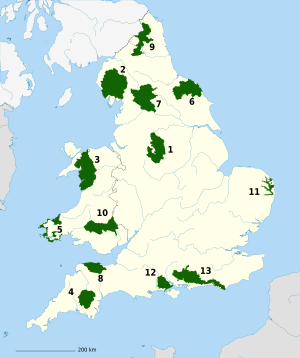National parks of the United Kingdom facts for kids
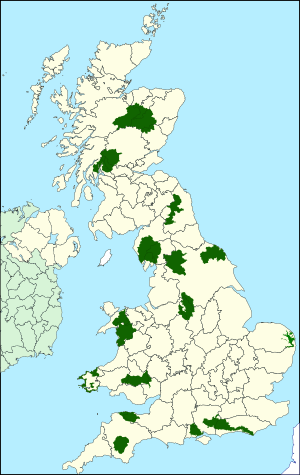
The National Parks of the United Kingdom are special places with beautiful landscapes. They are different from national parks in many other countries. In places like the USA, national parks are usually owned by the government and don't have many people living in them.
But in the UK, these parks can include towns, villages, and farms. The land is mostly owned by private people or groups. These parks are known for their amazing scenery. They have special rules to protect their beauty more than other areas.
The United Kingdom has fifteen national parks. Ten are in England, three are in Wales, and two are in Scotland. There are no national parks in Northern Ireland yet.
About 110 million people visit the national parks in England and Wales each year. This tourism helps the parks protect nature. It also creates jobs and businesses for local people. However, many visitors can cause problems like paths wearing away and too much traffic. Sometimes, there are disagreements about how to use the parks.
Contents
How National Parks are Managed
Each country in the UK manages its national parks differently. Scotland has its own laws, and England and Wales have theirs.
The main goals for national parks in England and Wales are:
- To protect and improve the natural beauty, wildlife, and history of the park.
- To help people learn about and enjoy the special qualities of the parks.
The Broads, which is like a national park, has a third goal:
- To protect how boats use the waterways.
Scottish national parks also have two more goals:
- To use natural resources in a way that can last a long time.
- To help local communities grow in a way that lasts.
Who Runs the Parks?
Each national park in England and Wales has its own special group called a national park authority. These groups started in 1997. Before that, most parks were run by local councils. The Peak District and Lake District parks had their own special boards even earlier. Scotland's parks also have similar authorities.
Most members of these park authorities are chosen by local councils. Others are chosen by government ministers. Some represent local villages, and others represent the whole country. These authorities work with other groups, like the National Trust, to manage the parks.
If there's a conflict between protecting nature and allowing visitors, protecting nature usually comes first. This is called the Sandford Principle. Park authorities also help local communities with their jobs and lives.
The money for national parks comes from the central government. In 2003/2004, the parks received about £35.5 million.
Other Important Groups
All UK national parks are part of National Parks UK. This group helps promote the parks and train their staff.
Natural England helps create new national parks in England. Natural Resources Wales does this for Wales. The Association of National Park Authorities speaks for all park authorities to the government. The Campaign for National Parks is a charity that works to protect and improve the parks in England and Wales.
How National Parks Were Created
National parks were first officially named in 1949. This happened after a long effort to allow public access to the countryside. People wanted to explore these beautiful areas, especially after the Industrial Revolution.
The idea for national parks in the UK started in the 1800s. Poets like William Wordsworth wrote about the beauty of places like the Lake District. He said it was "a sort of national property." But it took a long time for this idea to become law.
The first national parks were created in the 1950s. They were often in hilly areas that weren't used much for farming. Much of the land was still privately owned. It was also important that people from cities could easily reach them.
The Peak District became the first national park in April 1951. This was followed by the Lake District, Snowdonia, and Dartmoor in the same year. By the end of the 1950s, there were ten national parks.
Newer Parks
The Broads became a special area in 1988, with a status like a national park. It's known for its waterways.
Scotland created its own national parks, the Cairngorms and Loch Lomond and The Trossachs, in the early 2000s.
The New Forest became a national park in 2005. The South Downs became a national park in 2010.
The National Parks
Quick Facts
There are twelve national parks in England and Wales. Four are in the North of England, two in the Southwest, one in the North Midlands, and two in the South. Three are in Wales. They cover about 10.7% of England and 19.9% of Wales.
The Cairngorms National Park in Scotland is the largest, covering 4,528 square kilometers. The Lake District National Park is the largest in England and the second largest in the UK, at 2,292 square kilometers.
Snowdonia National Park is the largest in Wales, at 2,142 square kilometers.
The smallest national park in the UK is The Broads, at 303 square kilometers.
The Lake District is the most visited park, with 15.8 million visitors in 2009.
List of National Parks
| Name | Wider area | Photo | Country / County |
Date formed | Area |
|---|---|---|---|---|---|
| Peak District | The Peak | 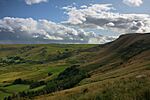 |
Derbyshire, Cheshire, Greater Manchester, Staffordshire, South Yorkshire, West Yorkshire 53°21′N 1°50′W / 53.350°N 1.833°W |
17 April 1951 | 1,438 square kilometres (555.2 sq mi) |
| Lake District | The Lakes | 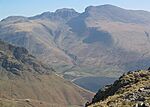 |
Cumbria 54°30′N 3°10′W / 54.500°N 3.167°W |
9 May 1951 | 2,292 square kilometres (884.9 sq mi) |
| Snowdonia (Welsh: Eryri) |
Snowdonia |  |
Gwynedd, Conwy 52°54′N 3°51′W / 52.900°N 3.850°W |
18 October 1951 | 2,142 square kilometres (827.0 sq mi) |
| Dartmoor | Devon |  |
Devon 50°34′N 4°0′W / 50.567°N 4.000°W |
30 October 1951 | 956 square kilometres (369.1 sq mi) |
| Pembrokeshire Coast (Welsh: Arfordir Penfro) |
Pembrokeshire | 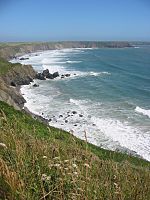 |
Pembrokeshire 51°50′N 5°05′W / 51.833°N 5.083°W |
29 February 1952 | 620 square kilometres (239.4 sq mi) |
| North York Moors | Cleveland |  |
North Yorkshire 54°23′N 0°45′W / 54.383°N 0.750°W |
29 November 1952 | 1,436 square kilometres (554.4 sq mi) |
| Yorkshire Dales | The Dales | 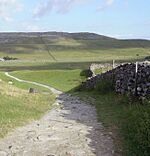 |
North Yorkshire, Cumbria, Lancashire 54°16′N 2°05′W / 54.267°N 2.083°W |
16 November 1954 | 2,179 square kilometres (841.3 sq mi) |
| Exmoor | Bristol Channel | 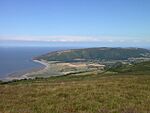 |
Somerset, Devon 51°06′N 3°36′W / 51.100°N 3.600°W |
19 October 1954 | 693 square kilometres (267.6 sq mi) |
| Northumberland | Border Moors and Forests | 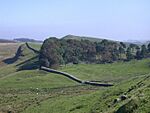 |
Northumberland 55°19′N 2°13′W / 55.317°N 2.217°W |
6 April 1956 | 1,049 square kilometres (405.0 sq mi) |
| Brecon Beacons (Welsh: Bannau Brycheiniog) |
Brecon Beacons | Blaenau Gwent, Carmarthenshire, Merthyr Tydfil, Powys, Rhondda Cynon Taf, Monmouthshire, Torfaen, Caerphilly 51°53′N 3°26′W / 51.883°N 3.433°W |
17 April 1957 | 1,351 square kilometres (521.6 sq mi) | |
| The Broads | East Anglia | 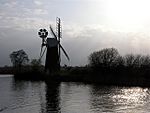 |
Norfolk, Suffolk 52°43′27″N 1°38′27″E / 52.72417°N 1.64083°E |
1 April 1989 | 303 square kilometres (117.0 sq mi) |
| Loch Lomond and The Trossachs | Highland Boundary Fault |  |
West Dunbartonshire, Argyll and Bute, Perth and Kinross, Stirling 56°15′N 4°37′W / 56.250°N 4.617°W |
24 April 2002 | 1,865 square kilometres (720.1 sq mi) |
| Cairngorms | The Cairngorms | 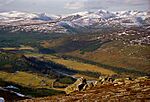 |
Highland, Moray, Aberdeenshire, Angus, Perth and Kinross 57°5′N 3°40′W / 57.083°N 3.667°W |
6 January 2003 | 4,528 square kilometres (1,748.3 sq mi) |
| New Forest | New Forest | 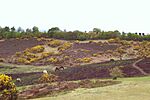 |
Hampshire, Wiltshire 50°52′N 1°34′W / 50.867°N 1.567°W |
1 March 2005 | 580 square kilometres (223.9 sq mi) |
| South Downs | Southern England Chalk Formation | 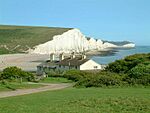 |
East Sussex, Hampshire, West Sussex 50°54′40″N 0°22′01″W / 50.911°N 0.367°W |
12 November 2009 2010 (operational) |
1,641 square kilometres (633.6 sq mi) |
National Parks in England
- Peak District: This park is special because it has plants and animals from both northern and southern England. It's at the end of the Pennines, which are like the "backbone of England." The southern part has limestone hills and valleys full of wildflowers. The northern part has dark moorland with rocks like shale and sandstone.
- Lake District: England's largest national park shows nearly 500 million years of Earth's history. It has England's biggest and deepest lakes and highest mountains. Thousands of years of human activity have shaped this land. You can find many different habitats here, from wetlands to mountain areas.
- Dartmoor: Dartmoor is the largest wild area in southern England. It has granite rocks that are 295 million years old. Almost half of the park is moorland. It has four national nature reserves and over forty special scientific sites. Dartmoor also has England's second highest waterfall.
- North York Moors: This park has old archaeological sites from the last ice age. It includes Iron Age forts, Roman forts, castles, and old industrial sites. Its rocks tell a story of ancient oceans, huge rivers, and ice sheets. Geologists have studied the area for over a century. It's also famous for fossils, like ammonites and dinosaur footprints.
- Yorkshire Dales: This park is in the middle of the Pennines. It has high peaks and deep valleys called "dales." The southern part has limestone scenery with caves. The northern part has moorland plateaus. The park is known for its features left by glaciers, like lakes and waterfalls.
- Exmoor: Most of Exmoor's rocks formed between 410 and 360 million years ago. The park rises to 519 meters at Dunkery Beacon. It has 55 kilometers of coastline with rivers flowing into the sea. The River Exe flows south and east. Many villages are found within the park.
- Northumberland: This is the least populated national park in England and Wales, with only about 2,000 people. It rises to 815 meters at The Cheviot. The park has over 1,100 kilometers of paths for walking, cycling, and horse-riding. It's also an international site for protecting wetlands. The park has a rich human history with many old buildings and monuments.
- The Broads: This is Britain's largest protected wetland. It's considered the eleventh national park, but it was created by its own special law in 1988. It has the same level of protection as a national park. Its rivers, shallow lakes (called broads), marshes, and fens are home to many rare plants and animals. It's also a popular place for boating. There are six rivers and 63 broads, with over 200 kilometers of waterways.
- New Forest: England's smallest national park was a hunting ground for William the Conqueror almost 1,000 years ago. Today, less than half of the park is covered by trees. The rest is heathland, open fields, marshes, villages, and coastline. It has the largest remaining lowland heath in Europe. Many animals roam freely here. The park is home to five types of deer, all British newt and snake species, and rare birds and insects. It also has many historical monuments.
- South Downs: This is the newest national park in the UK. It's a line of hills from Winchester to Eastbourne. The eastern part is mainly chalk hills. The western part is wider and includes chalk hills, sandstones, and clay. Most of the rocks formed 120 million years ago. Key habitats include chalk grassland and lowland heath. It has the largest population of any UK national park, with over 107,000 people. The park has a rich cultural history, from early human evidence to modern art. It contains many historical monuments and protected areas.
National Parks in Wales
- Snowdonia: This is the largest national park in Wales. It has the highest mountain in Wales, England, and Ireland, and Wales's largest natural lake. Over half of the people here speak Welsh. Fossils on Snowdon's summit are over 500 million years old. Glaciers from the Ice Age, 18,000 years ago, shaped the valleys here.
- Pembrokeshire Coast: This is the only UK national park mainly known for its coastline. It covers almost all the Pembrokeshire Coast, islands, an estuary, and hills. It's important for its many high-quality habitats and rare species. The park has many special conservation areas and nature reserves. It also has a rich human history, including the UK's smallest city, St Davids.
- Brecon Beacons: This was the last of the first ten national parks created in the 1950s. It sits between rural mid-Wales and industrial South Wales. Its mountains are mostly made of Old Red Sandstone. Like other UK mountain parks, glaciers from the Ice Age shaped many of its famous features. The western part of the park is a Geopark, known for its geology and waterfalls. Old tramroads and a canal from the Industrial Revolution are now used for recreation.
National Parks in Scotland
- Loch Lomond and The Trossachs: This park is the fourth largest in the UK. It includes 21 Munros (mountains over 3,000 feet) and 20 Corbetts (mountains between 2,500 and 3,000 feet). It also has two forest parks and two national nature reserves.
- Cairngorms: This is the largest national park in the United Kingdom. Its heart is the Cairngorms mountain range, but it also includes other hills and lower areas. Three major rivers start in this park: the Spey, the Dee, and the Don.
National Parks in Northern Ireland
There are no national parks in Northern Ireland yet. There have been talks about creating one in the Mourne Mountains.
Planning and Development in National Parks
National park authorities are in charge of planning for their areas. This means local councils don't control building plans there. The park authorities decide what can be built and how it should look. This gives them strong control over homes, factories, and other structures.
Their planning rules are stricter than in other places. The government supports this because it sees national park status as the highest level of protection for landscapes.
How Parks Help the Local Economy
Tourism is a big part of the economy in national park areas. Visitors spend money in shops, attractions, and hotels. This creates jobs for local people and farmers. For example, in 2004, visitors spent £185 million in the Peak District National Park. This supported over 3,400 jobs.
Challenges in National Parks
National park authorities have two main jobs: to protect the park and to help visitors enjoy it. Sometimes, these two goals can cause problems. About 110 million people visit the parks in England and Wales each year. While good management often helps, sometimes public access directly conflicts with protecting nature. When this happens, protecting nature usually comes first.
Tourism brings many good things, but also some problems:
- Crowded Areas: Popular spots can get very busy, especially on summer Sundays and holidays. This leads to full car parks, blocked roads, and busy local facilities. Examples include areas near Keswick in the Lake District and Castleton in the Peak District.
- Path Erosion: Walking and other activities on paths are very popular. Heavy use wears down the paths. Making paths stronger can look unnatural. Horse riding, mountain biking, and off-road vehicles also cause wear. Too much grazing by animals like sheep can also reduce plants, leading to more erosion.
- Harm to Wildlife: Too many people can disturb wildlife. Moorland and chalk grassland are easily damaged and take many years to recover. Ground-nesting birds are very sensitive. Activities like dog walking, orienteering, and hang gliding can disturb nesting birds.
- Litter: Rubbish is ugly and can harm animals. Broken glass is dangerous and can even start fires, especially in moorland areas.
- Damage to Farmland: Walking on grass fields can reduce food for farm animals. Walkers who leave paths might climb over fences instead of using stiles. Dogs not on leads can hurt or kill sheep, especially during lambing season.
- Local People Moving Out: Shops for tourists often make more money than shops for local people, like butchers or bakers. In some villages, there are few shops for locals. Houses in tourist villages can become very expensive. This is because people buy them as holiday homes or move there from cities. This makes it hard for local people to afford to live there. This is a big problem in parks near large cities, like the Peak District and the Lake District.
- Conflicts Between Visitors: Some activities can bother other visitors. For example, fast boats can create noise pollution. This can bother people who are on boat trips, sailing, canoeing, or swimming. On Windermere in the Lake District, a speed limit was put in place in 2005 to stop speedboats and water skiing.
Other Protected Landscapes
The UK has other special protected areas besides national parks. Areas of Outstanding Natural Beauty (AONBs) are similar but have fewer opportunities for outdoor recreation. Many national parks are next to AONBs. All parks also contain Sites of Special Scientific Interest and national nature reserves. Part of the Brecon Beacons National Park is also a UNESCO Global Geopark. The Lake District is a World Heritage Site. Parts of Snowdonia and the Brecon Beacons also include World Heritage Sites.


